Integrated Metabolomic and Transcriptomic Analyses Reveal the Basis for Carotenoid Biosynthesis in Sweet Potato (Ipomoea batatas (L.) Lam.) Storage Roots
- PMID: 36355093
- PMCID: PMC9699360
- DOI: 10.3390/metabo12111010
Integrated Metabolomic and Transcriptomic Analyses Reveal the Basis for Carotenoid Biosynthesis in Sweet Potato (Ipomoea batatas (L.) Lam.) Storage Roots
Abstract
Carotenoids are important compounds of quality and coloration within sweet potato storage roots, but the mechanisms that govern the accumulation of these carotenoids remain poorly understood. In this study, metabolomic and transcriptomic analyses of carotenoids were performed using young storage roots (S2) and old storage roots (S4) from white-fleshed (variety S19) and yellow-fleshed (variety BS) sweet potato types. S19 storage roots exhibited significantly lower total carotenoid levels relative to BS storage roots, and different numbers of carotenoid types were detected in the BS-S2, BS-S4, S19-S2, and S19-S4 samples. β-cryptoxanthin was identified as a potential key driver of differences in root coloration between the S19 and BS types. Combined transcriptomic and metabolomic analyses revealed significant co-annotation of the carotenoid and abscisic acid (ABA) metabolic pathways, PSY (phytoene synthase), CHYB (β-carotene 3-hydroxylase), ZEP (zeaxanthin epoxidase), NCED3 (9-cis-epoxycarotenoid dioxygenase 3), ABA2 (xanthoxin dehydrogenase), and CYP707A (abscisic acid 8'-hydroxylase) genes were found to be closely associated with carotenoid and ABA content in these sweet potato storage roots. The expression patterns of the transcription factors OFP and FAR1 were associated with the ABA content in these two sweet potato types. Together, these results provide a valuable foundation for understanding the mechanisms governing carotenoid biosynthesis in storage roots, and offer a theoretical basis for sweet potato breeding and management.
Keywords: abscisic acid; carotenoid; metabolome; sweet potato; transcriptome.
Conflict of interest statement
The authors declare no conflict of interest.
Figures

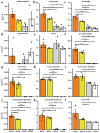
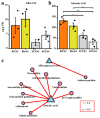
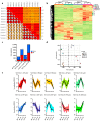
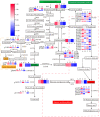
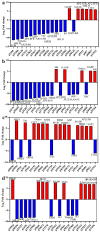
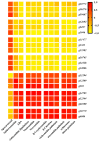
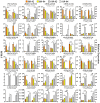
Similar articles
-
Manganese-regulated accumulation of carotenoids and abscisic acid in sweet potato through multi-omics analysis.J Sci Food Agric. 2025 Aug 15;105(10):5216-5226. doi: 10.1002/jsfa.14237. Epub 2025 Mar 25. J Sci Food Agric. 2025. PMID: 40130642
-
Natural allelic variation of basic helix-loop-helix transcription factor 25 regulates carotenoid biosynthesis in sweet potato.Plant Biotechnol J. 2025 Jul;23(7):2627-2644. doi: 10.1111/pbi.70086. Epub 2025 Apr 10. Plant Biotechnol J. 2025. PMID: 40209028 Free PMC article.
-
Exploring the differential mechanisms of carotenoid biosynthesis in the yellow peel and red flesh of papaya.BMC Genomics. 2019 Jan 16;20(1):49. doi: 10.1186/s12864-018-5388-0. BMC Genomics. 2019. PMID: 30651061 Free PMC article.
-
Deciphering the hormone regulatory mechanisms of storage root initiation in sweet potato: challenges and future prospects.AoB Plants. 2023 May 22;15(3):plad027. doi: 10.1093/aobpla/plad027. eCollection 2023 Jun. AoB Plants. 2023. PMID: 37292251 Free PMC article. Review.
-
Carotenoids in Potato Tubers: A Bright Yellow Future Ahead.Plants (Basel). 2025 Jan 18;14(2):272. doi: 10.3390/plants14020272. Plants (Basel). 2025. PMID: 39861622 Free PMC article. Review.
Cited by
-
A comprehensive overview of omics-based approaches to enhance biotic and abiotic stress tolerance in sweet potato.Hortic Res. 2024 Jan 12;11(3):uhae014. doi: 10.1093/hr/uhae014. eCollection 2024 Mar. Hortic Res. 2024. PMID: 38464477 Free PMC article.
-
Integrated metabolic and transcriptional analysis reveals the role of carotenoid cleavage dioxygenase 4 (IbCCD4) in carotenoid accumulation in sweetpotato tuberous roots.Biotechnol Biofuels Bioprod. 2023 Mar 14;16(1):45. doi: 10.1186/s13068-023-02299-y. Biotechnol Biofuels Bioprod. 2023. PMID: 36918944 Free PMC article.
References
-
- Li C., Kou M., Arisha M., Tang W., Ma M., Yan H., Wang X., Wang X., Zhang Y., Liu Y., et al. Transcriptomic and metabolic profiling of high-temperature treated storage roots reveals the mechanism of saccharification in sweetpotato (Ipomoea batatas (L.) Lam.) Int. J. Mol. Sci. 2021;22:6641. doi: 10.3390/ijms22136641. - DOI - PMC - PubMed
-
- Banda L., Kyallo M., Entfellner J.B.D., Moyo M., Swanckaert J., Mwanga R.O.M., Onyango A., Magiri E., Gemenet D.C., Yao N., et al. Analysis of β-amylase gene (Amyβ) variation reveals allele association with low enzyme activity and increased firmness in cooked sweetpotato (Ipomoea batatas) from East Africa. J. Agric. Food Res. 2021;4:100121. doi: 10.1016/j.jafr.2021.100121. - DOI - PMC - PubMed
Grants and funding
- SBGJXTZX-13/Ministerial and Provincial Co-Innovation Centre for Endemic Crops Production with High-quality and Efficiency in Loess Plateau
- G2022004009L/High-level Foreign Experts Introduction Project of China
- 202204010910001/Shanxi Key Laboratory of Minor Crops Germplasm Innovation and Molecular Breeding, Shanxi Agricultural University
- 202101140601027/Grand Science and Technology Special Project in Shanxi Province
- 2021Y332/Innovation Programs of Graduate Education in Shanxi
LinkOut - more resources
Full Text Sources

